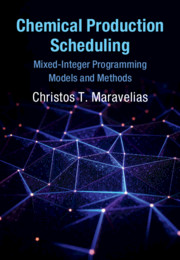Book contents
2 - Mixed-Integer Programming
from Part I - Background
Published online by Cambridge University Press: 01 May 2021
Summary
This chapter provides an overview of mixed-integer programming (MIP) modeling and solution methods.In Section 2.1, we present some preliminary concepts on optimization and mixed-integer programming. In Section 2.2, we discuss how binary variables can be used to model features commonly found in optimization problems. In Section 2.3, we present some basic MIP problems and models. Finally, in Section 2.4, we overview the basic approaches to solving MIP models and present some concepts regarding formulation tightness and decomposition methods.Finally, we discuss software tools for modeling and solving MIP models in Section 2.5.
Keywords
- Type
- Chapter
- Information
- Chemical Production SchedulingMixed-Integer Programming Models and Methods, pp. 32 - 64Publisher: Cambridge University PressPrint publication year: 2021

